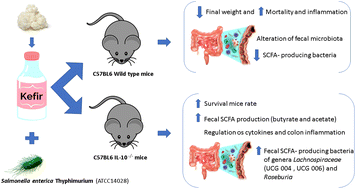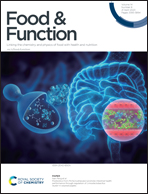The role of IL-10 in regulating inflammation and gut microbiome in mice consuming milk kefir and orally challenged with S. Typhimurium†
Abstract
Kefir has been suggested as a possible bacterial prophylaxis against Salmonella and IL-10 production seems to be crucial in the pathogenesis of salmonellosis in mice. This study evaluated the role of IL-10 in the inflammation and gut microbiome in mice consuming milk kefir and orally challenged with Salmonella enterica serovar Typhimurium. C57BL wild type (WT) (n = 40) and C57BL IL-10−/− (KO) (n = 40) mice were subdivided into eight experimental groups either treated or not with kefir. In the first 15 days, the water groups received filtered water (0.1 mL) while the kefir groups received milk kefir (10% w/v) orally by gavage. Then, two groups of each strain received a single dose (0.1 mL) of the inoculum of S. Typhimurium (ATCC 14028, dose: 106 CFU mL−1). After four weeks, the animals were euthanized to remove the colon for further analysis. Kefir prevented systemic infections only in IL-10−/− mice, which were able to survive, regulate cytokines, and control colon inflammation. The abundance in Lachnospiraceae and Roseburia, and also the higher SCFA production in the pre-infection, showed that kefir has a role in intestinal health and protection, colonizing and offering competition for nutrients with the pathogen as well as acting in the regulation of salmonella infectivity only in the absence of IL-10. These results demonstrate the role of IL-10 in the prognosis of salmonellosis and how milk kefir can be used in acute infections.



 Please wait while we load your content...
Please wait while we load your content...